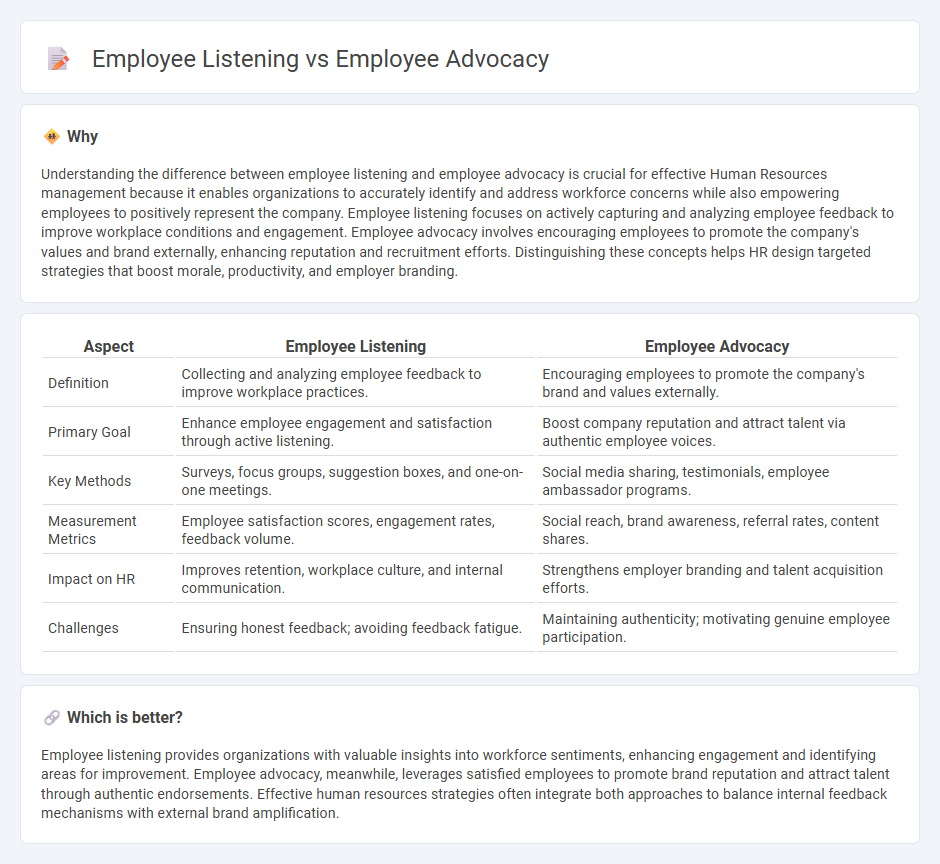
Employee listening involves systematically gathering and analyzing employee feedback to understand workplace sentiments and improve organizational culture. Employee advocacy empowers staff to represent and promote the company's values and goals, enhancing brand reputation and employee engagement. Discover how integrating these strategies can transform your human resources approach.
Why it is important
Understanding the difference between employee listening and employee advocacy is crucial for effective Human Resources management because it enables organizations to accurately identify and address workforce concerns while also empowering employees to positively represent the company. Employee listening focuses on actively capturing and analyzing employee feedback to improve workplace conditions and engagement. Employee advocacy involves encouraging employees to promote the company's values and brand externally, enhancing reputation and recruitment efforts. Distinguishing these concepts helps HR design targeted strategies that boost morale, productivity, and employer branding.
Comparison Table
| Aspect | Employee Listening | Employee Advocacy |
|---|---|---|
| Definition | Collecting and analyzing employee feedback to improve workplace practices. | Encouraging employees to promote the company's brand and values externally. |
| Primary Goal | Enhance employee engagement and satisfaction through active listening. | Boost company reputation and attract talent via authentic employee voices. |
| Key Methods | Surveys, focus groups, suggestion boxes, and one-on-one meetings. | Social media sharing, testimonials, employee ambassador programs. |
| Measurement Metrics | Employee satisfaction scores, engagement rates, feedback volume. | Social reach, brand awareness, referral rates, content shares. |
| Impact on HR | Improves retention, workplace culture, and internal communication. | Strengthens employer branding and talent acquisition efforts. |
| Challenges | Ensuring honest feedback; avoiding feedback fatigue. | Maintaining authenticity; motivating genuine employee participation. |
Which is better?
Employee listening provides organizations with valuable insights into workforce sentiments, enhancing engagement and identifying areas for improvement. Employee advocacy, meanwhile, leverages satisfied employees to promote brand reputation and attract talent through authentic endorsements. Effective human resources strategies often integrate both approaches to balance internal feedback mechanisms with external brand amplification.
Connection
Employee listening involves systematically gathering feedback through surveys, interviews, and real-time analytics to understand workforce sentiments, which directly informs employee advocacy strategies that empower staff as brand ambassadors and champions of organizational culture. By leveraging insights from employee listening, human resources can tailor advocacy programs that boost engagement, improve retention, and enhance employer branding. This interconnected approach maximizes the impact of employee voices in shaping a positive workplace environment and driving business performance.
Key Terms
Employee Engagement
Employee advocacy drives employee engagement by empowering staff to share positive company messages, boosting brand visibility and morale. Employee listening enhances engagement through feedback mechanisms that foster a culture of trust and continuous improvement. Explore more about how these strategies can transform your organization's employee experience.
Employee Voice
Employee advocacy centers on empowering employees to actively promote company values and brand externally, amplifying the organization's positive image. Employee listening prioritizes gathering authentic feedback from employees to understand their experiences, concerns, and ideas, enhancing workplace culture and decision-making. Explore how leveraging both strategies can strengthen Employee Voice and drive organizational success.
Organizational Culture
Employee advocacy drives organizational culture by empowering staff to represent brand values externally, fostering a unified and positive workplace identity. Employee listening enhances culture through active feedback collection, enabling leadership to address concerns and align practices with employee needs. Explore how integrating both strategies can transform your organizational culture comprehensively.
Source and External Links
Employee Advocacy on Social Media: Benefits, Examples & Strategies - Employee advocacy is when employees act as spokespersons for their employer's brand, sharing company content and engaging with their networks, with best practices including training all employees and providing shareable content regularly.
What Is Employee Advocacy and Does It Really Work? - Sprout Social - Employee advocacy involves employees actively promoting their company's brand on social media through their personal networks, which boosts brand awareness and supports messaging control, with executive involvement being key to program success.
15 Employee Advocacy Examples To Guide Your Own Program - Real-world examples from companies like Adobe, Cisco, Coca-Cola, and Dell demonstrate how employee advocacy programs empower staff with training and content to share the company's message, enhancing brand reputation and engagement.
 dowidth.com
dowidth.com